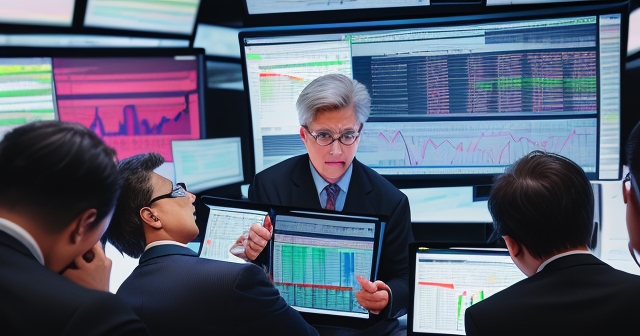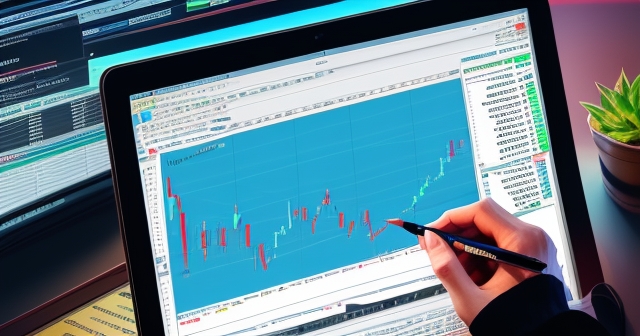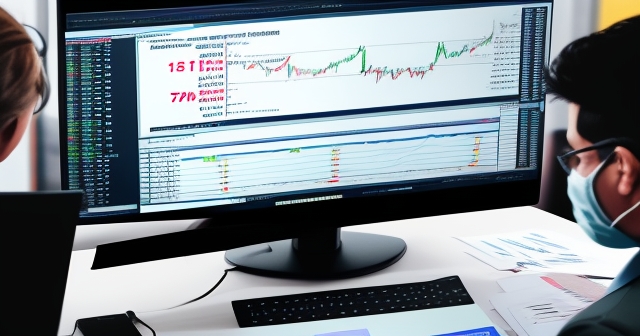Navigating Market Volatility: Unpacking the Modern Trading Edge
Hello, fellow travelers on the investment path. We find ourselves in a financial landscape that often feels less like a calm sea and more like a choppy, unpredictable tide. Market indicators are mixed, corporate earnings reports offer surprises both pleasant and challenging, and global trade policies cast long, sometimes uncertain, shadows. In such an environment, simply participating isn’t enough. To consistently navigate these waters and find potential for profit, you need something more. You need a trading edge.
But what exactly is a trading edge? Is it a secret formula, a crystal ball, or just sheer luck? As your guide, we’re here to tell you it’s none of those, yet encompasses elements of insight, speed, and disciplined strategy. Think of it as your unique advantage, the specific approach or perspective that gives you a higher probability of successful trades compared to random chance or the average market participant. In the complex interplay of economic data, corporate performance, and shifting sentiment, identifying and leveraging your edge is paramount. Let’s explore how to find yours.
- A trading edge provides a systematic approach to improve your trading outcomes.
- It involves understanding the market dynamics and individual asset performances.
- Defining your trading style can help you uncover the best strategies to exploit opportunities.
Decoding the Current Market Landscape: Where Opportunity Hides
Before we define the edge, we must understand the terrain. Recently, we’ve observed U.S. stock markets, including stalwarts like the Dow Jones Industrial Average, the broad-based S&P 500, and the tech-heavy Nasdaq Composite, experiencing periods of significant fluctuation. They might end higher some days, driven by optimistic earnings, only to face headwinds the next from unexpected economic data or trade policy announcements.

Consider the mixed signals we’ve seen. Some companies, like Honeywell, Sherwin-Williams, and Coca-Cola, have reported earnings that beat expectations, providing a lift to their respective sectors and indexes. This demonstrates the power of individual company performance to influence market segments. Yet, others face direct challenges. General Motors (GM), for instance, pulled its financial forecast, explicitly citing uncertainty related to tariffs. This isn’t just a corporate issue; it’s a clear example of how macro-level trade policy directly impacts company guidance and, consequently, investor confidence and stock valuations.
Economic data also paints a complex picture. We saw the U.S. trade deficit widen significantly in March, partly attributed to businesses importing goods preemptively ahead of potential tariffs. Meanwhile, consumer confidence dropped to its lowest level since May 2020, with analysts suggesting a link to tariff impacts influencing consumer expectations. These aren’t just abstract numbers; they reflect real economic activity and sentiment that can influence market trends and sector performance.
Upcoming data points, such as the PCE price index (a key inflation gauge), the final reading of Q1 GDP (economic growth), and the crucial government payrolls report (labor market health), will continue to provide pieces to this economic puzzle. Each release is a potential catalyst for market movement, requiring traders to be prepared not just for the data itself, but for the market’s *reaction* to it. Understanding this dynamic, volatile environment is the essential first step in cultivating a robust trading edge.
The Essence of a Trading Edge: What is It, Really?
So, what exactly are we talking about when we say “trading edge”? At its core, a trading edge is any sustainable advantage that allows you to make profitable trades over time. It’s not about winning every single trade – that’s an impossible goal. Instead, it’s about having a strategy or approach that, over a series of trades, yields a positive expected outcome. Think of it like a casino: the house doesn’t win every hand, but the rules are tilted slightly in its favor, ensuring profitability over the long run. Your trading edge is about tilting those odds in *your* favor.
This edge can manifest in various ways, and it often depends on your trading style, time horizon, and the markets you focus on (be it stocks, options, futures, or even FOREX and CFDs). A short-term day trader will likely have a different type of edge than a long-term fundamental investor or a quantitative hedge fund. Understanding your own strengths and the specific market inefficiencies you can exploit is key to defining what your personal trading edge will be.
If you’re looking to explore markets like Forex and CFDs, understanding how different platforms can support your strategy is crucial. Moneta Markets, an Australian-based platform, offers a wide range of over 1000 financial instruments, including Forex and various CFDs. This breadth of offering can be part of building your edge by providing access to diverse markets.
| Market Types | Edge Characteristics |
|---|---|
| Stocks | Focus on individual company fundamentals |
| Forex | Leverage measures, macro factors |
| CFDs | Access to diverse asset classes |
Speed as an Edge: The Power of Rapid Informational Access
In today’s interconnected world, information is king, and speed can be a significant edge, especially for short-term traders or those focused on event-driven strategies. One definition of a trading edge mentioned in market commentary is having “lightning fast access to accurate analysis” of market-moving information. Think about those crucial economic data releases or unexpected corporate earnings pre-announcements. The market often reacts instantly as this information hits the wires.

If you are among the first to receive, interpret, and act upon this data, you can potentially gain an advantage over those who receive it later or take longer to understand its implications. This isn’t about illegal insider information; it’s about legal, public information disseminated rapidly through specialized news services and platforms designed for professional traders. Services like Trade The News, or similar fast-feed providers, specialize in delivering headlines and summarized analysis with incredible speed. For traders whose strategies depend on capturing momentum from breaking news, this speed *is* their edge.
Consider the impact of a sudden trade policy announcement, like tariff relief for automakers as discussed by the Commerce Secretary. While the immediate market reaction might be muted (as noted with GM shares initially), understanding the policy’s potential long-term implications for the industry or supply chains requires deeper analysis. But the initial move often belongs to those with the fastest information flow.
Deeper Dive: Analyzing Market-Moving Information Effectively
Beyond just speed, the *ability to analyze* information accurately and quickly is a critical component of the informational edge. Receiving news headlines at lightning speed is useless if you can’t rapidly understand their potential impact on specific assets or the broader market. This requires expertise and experience.
Analyzing market-moving information involves several steps:
- Filtering: Not all news is equal. You need to quickly identify which headlines are truly market-moving for the assets you trade.
- Interpretation: What does the economic data (like the trade deficit or consumer confidence figures) *really* mean for future economic growth, inflation, or potential central bank action? How does a company’s earnings beat/miss translate into future growth prospects or valuation adjustments?
- Contextualization: How does this new piece of information fit into the existing market narrative? Does it confirm or contradict recent trends? Does it change the probability of future events (like policy changes)?
- Action Planning: Based on your interpretation, what is the appropriate trading action? Does it trigger a buy, sell, or hold decision according to your pre-defined strategy?
| Analysis Steps | Description |
|---|---|
| Filtering | Identify critical news affecting assets. |
| Interpretation | Assess implications of economic data. |
| Contextualization | Understand how data fits in the market narrative. |
| Action Planning | Plan trading actions based on analysis. |
This analytical process isn’t innate; it’s developed through years of studying market behavior, understanding economic principles, following industry dynamics, and learning from experience. For instance, understanding why a widened trade deficit might correlate with businesses front-loading imports due to tariff concerns, or why consumer confidence is linked to expectations about future income and business conditions, requires a solid grasp of economics. The analytical edge is built on this foundation of knowledge and practiced skill, allowing you to translate raw information into profitable trading decisions.
The Quantitative Edge: Exploiting Market Inefficiencies
Moving beyond pure information speed, another powerful type of trading edge stems from the world of quantitative finance. From this perspective, a trading edge is defined as having a “positive expected value from exploiting a market inefficiency.” This view is less about reacting to breaking news in seconds and more about identifying persistent patterns or mispricings in the market that can be systematically exploited using mathematical and statistical models.

What are market inefficiencies? In theory, efficient markets instantly price in all available information, making it impossible to consistently profit from it. However, real-world markets aren’t perfectly efficient. Human behavior (fear, greed), structural issues (liquidity constraints, regulatory hurdles), and the sheer volume of information can create temporary or even persistent situations where assets are mispriced relative to their true value or historical relationships. A quantitative edge is about finding these imperfections and designing strategies to profit from them reliably.
A strategy based on a quantitative edge often involves:
- Identifying a potential market inefficiency (e.g., assets that tend to revert to a mean, seasonal patterns, correlations between different instruments).
- Developing a testable hypothesis about this inefficiency.
- Building a mathematical model based on historical data to test the hypothesis and define entry/exit rules.
- Implementing the strategy systematically, often through algorithmic trading, to execute trades precisely when the model indicates an opportunity with a positive expected value.
| Strategy Components | Description |
|---|---|
| Identifying Inefficiencies | Spot market patterns for potential profits. |
| Hypothesis Development | Create testable assumptions for the market. |
| Model Building | Use historical data to validate assumptions. |
| Systematic Implementation | Execute trades based on the model’s signals. |
The “positive expected value” is key here. It means that while any single trade might lose money, the strategy as a whole, executed repeatedly over many opportunities, is statistically likely to generate profit over time. This requires rigorous backtesting and statistical analysis to ensure the identified inefficiency is real and exploitable.
Building Your Model: Investing Factors
How do quantitative traders identify these inefficiencies and build their models? They often rely on what are called “investing factors.” These are characteristics of assets or relationships between them that academic research and empirical observation have shown to be associated with higher or lower returns over time. These factors serve as the building blocks for quantitative trading strategies aimed at generating Alpha.
What is Alpha? Alpha is the excess return of an investment or trading strategy relative to the return of a relevant benchmark index (like the S&P 500), after accounting for systematic risks (like market volatility). If a strategy generates positive alpha, it suggests it has successfully exploited market inefficiencies to produce returns superior to what would be expected simply by taking on market risk. Generating alpha is the ultimate goal of quantitative trading and the hallmark of a successful quantitative edge.
Investing factors can broadly be categorized into:
- Fundamental Factors: Based on financial data and economic theory (e.g., value – buying undervalued assets, growth – buying companies with high earnings growth, quality – buying profitable companies with stable earnings).
- Technical Factors: Based on price and volume data, identifying patterns and trends (e.g., momentum – buying assets that have performed well recently, mean reversion – betting that prices will move back towards their average).
- Statistical Factors: Derived from statistical relationships between assets, often using advanced mathematical techniques (e.g., statistical arbitrage – exploiting temporary price differences between highly correlated assets).
A quantitative edge might involve building a model that combines multiple factors, seeking complex relationships that are not immediately obvious or easily exploitable by human traders relying solely on intuition or fundamental analysis. This approach requires significant computational power, data analysis skills, and a deep understanding of statistics and probability.
The Challenge of Alpha Decay: Why Your Edge Needs Constant Adaptation
Markets are dynamic ecosystems. Information flows faster, new participants enter, regulations change, and existing inefficiencies get arbitraged away as more traders exploit them. This leads to a phenomenon known as alpha decay. What was a profitable trading edge yesterday might become less effective, or even unprofitable, tomorrow.
Think about it: if a quantitative model identifying a specific pattern becomes widely used, the collective actions of traders exploiting that pattern will likely reduce its profitability. The pattern might weaken, disappear, or change its characteristics entirely. Similarly, an informational edge based on speed might diminish as technology makes rapid data dissemination more ubiquitous for everyone.
Therefore, maintaining a trading edge is not a one-time achievement; it requires continuous effort, research, and adaptation. Successful professional traders and quantitative firms are constantly:
- Monitoring the performance of their existing strategies.
- Researching new potential sources of edge.
- Refining their models and analytical processes.
- Adapting to changing market structures and participant behavior.
The market is like a constantly moving target. Your edge is only sustainable if you are willing and able to keep up, evolving your strategies as the market itself evolves. This commitment to continuous improvement is a non-negotiable aspect of long-term trading success.
Combining Edges: Integrating Information and Quantitative Approaches
While we’ve discussed the informational edge and the quantitative edge somewhat separately, in practice, sophisticated traders often combine aspects of both. Macro information and breaking news can provide the context and potential catalysts, while quantitative models can offer precise entry and exit signals based on identified statistical patterns.
For example, a quantitative trader might have a model based on mean reversion in a specific sector. However, a sudden earnings announcement or a trade policy shift related to that sector could temporarily disrupt the expected pattern. A trader with an integrated edge would use their informational awareness to understand *why* the model might be behaving unexpectedly, and potentially pause or adjust the strategy based on the qualitative information.
Conversely, a trader primarily focused on news might use quantitative tools to filter potential trade opportunities or manage risk. They might use charting tools based on technical factors to identify precise entry points after a news release, or use statistical measures of volatility to size their positions appropriately.
The most robust trading edges are often those that can synthesize different types of information and analytical approaches. It’s about building a comprehensive understanding of the market, from the macro-level impacts of economic data and policy to the micro-level price dynamics captured by quantitative models. Your unique combination of skills, resources, and market focus will determine the optimal blend for you.
Practical Steps: Finding and Refining Your Own Edge
So, how can you, as an investor or trader, begin to find and refine your own trading edge? It starts with self-assessment and exploration.
- Understand Yourself: What are your strengths? Are you better at quick reaction and pattern recognition (potentially leaning towards an informational edge)? Or do you prefer deep analysis, statistical modeling, and systematic approaches (leaning towards a quantitative edge)? What is your risk tolerance and time horizon?
- Choose Your Focus: What markets or instruments genuinely interest you? Stocks, Forex, commodities, options? Different markets have different characteristics and dominant inefficiencies.
- Educate Yourself: Dive deep into the type of analysis that aligns with your potential edge. Study fundamental analysis, technical analysis, economics, statistics, or quantitative finance, depending on your chosen path.
- Develop a Strategy: Based on your self-assessment and market focus, formulate a specific, testable trading strategy. Define clear entry and exit rules, position sizing, and risk management protocols.
- Test Rigorously: Backtest your strategy using historical data (if quantitative) or simulate it using real-time data without risking capital. Does it show a positive expected value over a significant sample size?
- Start Small and Learn: Begin trading with real, but limited, capital. Monitor your results meticulously. What’s working? What isn’t? Where is your edge strongest, and where is it weakest?
- Keep a Trading Journal: Document every trade, your reasoning, the outcome, and your emotional state. This is invaluable for identifying patterns in your own performance and understanding where your edge truly lies.
- Iterate and Adapt: The market changes, and so must your approach. Continuously review your performance, refine your strategy, and be prepared to adapt as your edge faces alpha decay.
Finding your edge is an ongoing journey, not a destination. It requires discipline, persistence, and a commitment to continuous learning and improvement. It might take time to discover what works best for you, but the process of systematic exploration and refinement is how a sustainable edge is built.
Resources and Tools for Edge Seekers
Fortunately, you don’t have to navigate this journey entirely alone. A wealth of resources and tools are available to help you find, build, and maintain your trading edge. These range from educational materials to sophisticated software and data services.
- High-Speed News & Data Services: For those seeking an informational edge, services like Trade The News, Bloomberg, or Reuters provide real-time, low-latency access to market-moving information.
- Charting and Technical Analysis Platforms: Tools like Trendspider or TradingView offer advanced charting capabilities and indicators essential for developing technical analysis-based edges.
- Fundamental Data Providers: Platforms providing detailed company financials, economic data archives, and analyst reports are crucial for fundamental analysis-based strategies.
- Backtesting Software: Tools and programming environments (like Python with libraries such as Pandas and NumPy) allow quantitative traders to test their models against historical data.
- Trading Journals & Analytics Platforms: Services that help you log trades and analyze your performance provide crucial insights into your strengths and weaknesses.
- Educational Courses & Books: Numerous resources exist to teach you about market mechanics, different trading strategies, risk management, and quantitative methods.
- Trading Communities & Mentors: Learning from experienced traders and discussing ideas within a community can accelerate your learning process and expose you to new perspectives.
Selecting the right tools depends heavily on the type of edge you are pursuing. A news trader needs speed, while a quantitative trader needs data and processing power. Don’t feel pressured to use everything; identify the resources that directly support your chosen approach and help you execute your strategy effectively.

When choosing a trading platform, consider one that offers the flexibility and technology you need to implement your chosen strategy. Moneta Markets supports popular platforms like MT4, MT5, and Pro Trader, known for their charting tools, algorithmic trading capabilities, and fast execution, which can be vital for maintaining an edge.
Conclusion: Sustaining Success in the Market’s Ever-Changing Tides
In the dynamic and sometimes turbulent world of financial markets, a well-defined and continuously refined trading edge is not a luxury, but a necessity for achieving sustainable success. Whether your edge comes from the ability to rapidly process and analyze market-moving information, or from the systematic exploitation of market inefficiencies through quantitative models and factors, it represents your unique path to potentially tilting the odds in your favor.
We’ve seen how macro factors like trade policy and economic data, alongside micro factors like individual corporate earnings, contribute to the market’s complexity. Your edge is your ability to navigate this complexity effectively. It requires expertise, discipline, and a commitment to lifelong learning and adaptation in the face of alpha decay.
Finding your edge is a personal and iterative process. It involves understanding your strengths, choosing your focus, building a robust strategy, testing it rigorously, and constantly refining your approach based on real-world performance. By combining knowledge, effective tools, and persistent effort, you can build a sustainable edge that allows you to not just survive, but potentially thrive, in the ever-changing tides of the financial markets.
If you are exploring options for executing your trading strategies across global markets, considering a broker with regulatory assurance and comprehensive support is prudent. Moneta Markets holds multiple regulatory licenses including FSCA, ASIC, and FSA, and offers features like segregated client funds, free VPS services, and 24/7 customer support, which can provide a reliable infrastructure for traders seeking an edge.
trading edgeFAQ
Q:What is a trading edge?
A:A trading edge is a unique advantage or strategy that increases the probability of successful trades over random chance.
Q:How can I find my trading edge?
A:Finding your edge involves self-assessment, market exploration, and developing a trading strategy that aligns with your strengths.
Q:Why is speed important in trading?
A:Speed allows traders to access and act on market-moving information faster than others, capitalizing on short-term opportunities.

留言